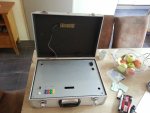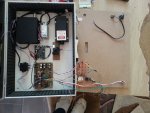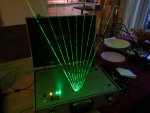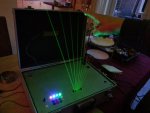Yeah, the display on my harp was basically useless, you couldn't program the harp from it either, it as basically a status indicator. If I did include a screen in the newer versions, it would have been one big enough, possibly witha touchscreen to make that easier.
And yeah, I have considered the raspi, though it'd be a huge project as I've had very little linux programming experience.
The harp hardware wise is quite simple, it's the code that can get tricky fast. It took me a good while to optimize it to run fast enough.
PS: I noticed in your other thread you're trying to get brighter beams. One way I solved this is to have the galvo's "wait" at each beam for a bit longer. Instead of just scanning a line and turning the laser on and off at the right time, have the galvo's actually stop at the point, say for 5ms or something. This is especially helpful with green lasers, as they do take some time to actually start lasing, but also because the human eye is pretty slow, so if the beam isn't there for long, it's apparent brightness will be much lower too.







